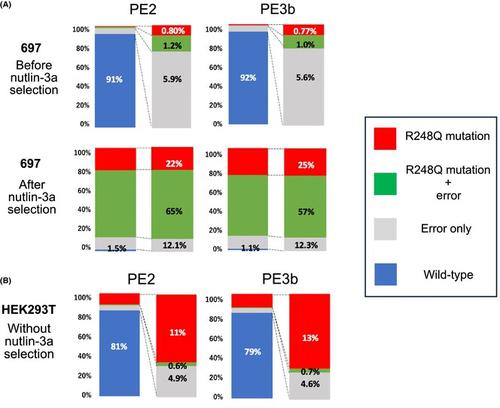当前位置:
X-MOL 学术
›
Cancer Sci.
›
论文详情
Our official English website, www.x-mol.net, welcomes your feedback! (Note: you will need to create a separate account there.)
Application of prime editing system to introduce TP53 R248Q hotspot mutation in acute lymphoblastic leukemia cell line
Cancer Science ( IF 5.7 ) Pub Date : 2024-03-29 , DOI: 10.1111/cas.16162 Thao Nguyen 1 , Tomomi Aida 2 , Yuka Iijima‐Yamashita 3 , Minori Tamai 1 , Akiko Nagamachi 4 , Keiko Kagami 1 , Chiaki Komatsu 1 , Shin Kasai 1 , Koshi Akahane 1 , Kumiko Goi 1 , Toshiya Inaba 4 , Masashi Sanada 3 , Takeshi Inukai 1
Cancer Science ( IF 5.7 ) Pub Date : 2024-03-29 , DOI: 10.1111/cas.16162 Thao Nguyen 1 , Tomomi Aida 2 , Yuka Iijima‐Yamashita 3 , Minori Tamai 1 , Akiko Nagamachi 4 , Keiko Kagami 1 , Chiaki Komatsu 1 , Shin Kasai 1 , Koshi Akahane 1 , Kumiko Goi 1 , Toshiya Inaba 4 , Masashi Sanada 3 , Takeshi Inukai 1
Affiliation

|
In childhood acute lymphoblastic leukemia (ALL), TP53 gene mutation is associated with chemoresistance in a certain population of relapsed cases. To directly verify the association of TP53 gene mutation with chemoresistance of relapsed childhood ALL cases and improve their prognosis, the development of appropriate human leukemia models having TP53 mutation in the intrinsic gene is required. Here, we sought to introduce R248Q hotspot mutation into the intrinsic TP53 gene in an ALL cell line, 697, by applying a prime editing (PE) system, which is a versatile genome editing technology. The PE2 system uses an artificial fusion of nickase Cas9 and reverse‐transcriptase to directly place new genetic information into a target site through a reverse transcriptase template in the prime editing guide RNA (pegRNA). Moreover, in the advanced PE3b system, single guide RNA (sgRNA) matching the edited sequence is also introduced to improve editing efficiency. The initially obtained MDM2 inhibitor‐resistant PE3b‐transfected subline revealed disrupted p53 transactivation activity, reduced p53 target gene expression, and acquired resistance to chemotherapeutic agents and irradiation. Although the majority of the subline acquired the designed R248Q and adjacent silent mutations, the insertion of the palindromic sequence in the scaffold hairpin structure of pegRNA and the overlap of the original genomic DNA sequence were frequently observed. Targeted next‐generation sequencing reconfirmed frequent edit errors in both PE2 and PE3b‐transfected 697 cells, and it revealed frequent successful edits in HEK293T cells. These observations suggest a requirement for further modification of the PE2 and PE3b systems for accurate editing in leukemic cells.
中文翻译:

应用prime编辑系统在急性淋巴细胞白血病细胞系中引入TP53 R248Q热点突变
在儿童急性淋巴细胞白血病(ALL)中,TP53 基因突变与某些复发病例群体的化疗耐药性相关。直接验证关联TP53 复发性儿童 ALL 病例的基因突变与化疗耐药并改善其预后,开发适当的人类白血病模型TP53 需要内在基因发生突变。在这里,我们试图将 R248Q 热点突变引入内在TP53 通过应用prime编辑(PE)系统,这是一种多功能基因组编辑技术,在ALL细胞系697中基因。 PE2系统使用切口酶Cas9和逆转录酶的人工融合,通过prime编辑向导RNA(pegRNA)中的逆转录酶模板将新的遗传信息直接放入目标位点。此外,在先进的PE3b系统中,还引入了与编辑序列匹配的单引导RNA(sgRNA),以提高编辑效率。最初获得的 MDM2 抑制剂抗性 PE3b 转染亚系显示 p53 反式激活活性被破坏,p53 靶基因表达减少,并且获得了对化疗药物和放射的抗性。尽管大多数亚系获得了设计的R248Q和相邻的沉默突变,但经常观察到回文序列插入pegRNA的支架发夹结构中以及原始基因组DNA序列的重叠。靶向下一代测序再次证实了 PE2 和 PE3b 转染的 697 细胞中频繁出现的编辑错误,并且揭示了 HEK293T 细胞中频繁的成功编辑。这些观察结果表明需要进一步修改 PE2 和 PE3b 系统,以便在白血病细胞中进行精确编辑。
更新日期:2024-03-29
中文翻译:

应用prime编辑系统在急性淋巴细胞白血病细胞系中引入TP53 R248Q热点突变
在儿童急性淋巴细胞白血病(ALL)中,



























 京公网安备 11010802027423号
京公网安备 11010802027423号